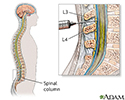CSF smear
Spinal fluid smear; Cerebrospinal fluid smear
A cerebrospinal fluid smear is a laboratory test to look for bacteria, fungi, and viruses in the fluid that moves in the space around the spinal cord and brain. Cerebrospinal fluid (CSF) protects the brain and spinal cord from injury.
How the Test is Performed
A sample of CSF is needed. This is usually done with a lumbar puncture, or a spinal tap .
Spinal tap
Cerebrospinal fluid (CSF) collection is a test to look at the fluid that surrounds the brain and spinal cord. CSF acts as a cushion, protecting the b...

The sample is sent to a laboratory. There, a tiny amount is spread on a glass slide. Laboratory staff then view the sample under a microscope. The smear shows the color of the fluid and the number and shape of cells present in the fluid. Other tests may be done to check for bacteria or fungi in the sample.
How to Prepare for the Test
Follow instructions on how to prepare for a spinal tap .
Spinal tap
Cerebrospinal fluid (CSF) collection is a test to look at the fluid that surrounds the brain and spinal cord. CSF acts as a cushion, protecting the b...

Why the Test is Performed
Your health care provider may order this test if you have signs of an infection that affects the brain or nervous system. The test helps identify what is causing the infection. This will help your provider decide on the best treatment
Normal Results
A normal test result means there are no signs of an infection. This is also called a negative result. However, a normal result doesn't mean that there is no infection. The spinal tap and CSF smear may need to be done again.
What Abnormal Results Mean
Bacteria or other germs found in the sample may be a sign of meningitis. This is an infection of the membranes covering the brain and spinal cord. The infection can be caused by bacteria , fungi, or viruses.
Bacteria
Meningitis is an infection of the membranes covering the brain and spinal cord. This covering is called the meninges.

Risks
A laboratory smear poses no risk. Your provider will tell you about the risks of a spinal tap .
Spinal tap
Cerebrospinal fluid (CSF) collection is a test to look at the fluid that surrounds the brain and spinal cord. CSF acts as a cushion, protecting the b...

References
Karcher DS, McPherson RA. Cerebrospinal, synovial, serous body fluids, and alternative specimens. In: McPherson RA, Pincus MR, eds. Henry's Clinical Diagnosis and Management by Laboratory Methods . 23rd ed. Philadelphia, PA: Elsevier; 2017:chap 29.
O'Connell TX. Cerebrospinal fluid evaluation. In: O'Connell TX, ed. Instant Work-Ups: A Clinical Guide to Medicine . 2nd ed. Philadelphia, PA: Elsevier; 2017:chap 9.
-
CSF smear - illustration
Cerebral spinal fluid (CSF) is a clear fluid that circulates in the space surrounding the spinal cord and brain. CSF protects the brain and spinal cord from injury by acting like a liquid cushion. CSF is usually obtained through a lumbar puncture (spinal tap). During the procedure, a needle is inserted usually between the 3rd and 4th lumbar vertebrae and the CSF fluid is collected for testing.
CSF smear
illustration
-
CSF smear - illustration
Cerebral spinal fluid (CSF) is a clear fluid that circulates in the space surrounding the spinal cord and brain. CSF protects the brain and spinal cord from injury by acting like a liquid cushion. CSF is usually obtained through a lumbar puncture (spinal tap). During the procedure, a needle is inserted usually between the 3rd and 4th lumbar vertebrae and the CSF fluid is collected for testing.
CSF smear
illustration
Review Date: 7/31/2016
Reviewed By: Jatin M. Vyas, MD, PhD, Assistant Professor in Medicine, Harvard Medical School; Assistant in Medicine, Division of Infectious Disease, Department of Medicine, Massachusetts General Hospital, Boston, MA. Also reviewed by David Zieve, MD, MHA, Isla Ogilvie, PhD, and the A.D.A.M. Editorial team.

